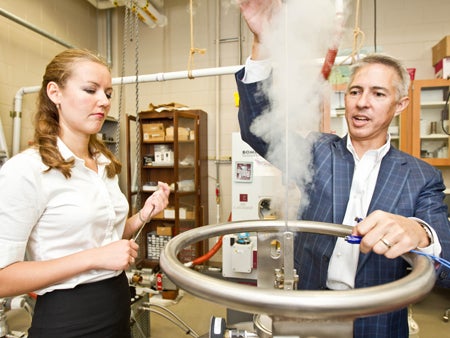Because space dust contains the basic ingredients that form planets, the University of Central Florida physicists’ analysis could provide important clues about how the solar system formed and how life emerged.
For decades, astrophysicists have been studying these clouds of dust, which contain ices, silicate minerals and iron compounds. But until the UCF team started looking at earth’s minerals with far IR spectroscopy, identifying the minerals in space dust was . . . ambiguous at best.
“It was an educated best guess,” said Robert Peale, a physics professor who has worked on mineral sampling projects at UCF since 1991. “We’ve analyzed more than 160 minerals found on earth. Now we can compare our findings with new results coming in from the European Space Agency’s Herschel telescope and start making some headway.”
Scientists have been using Herschel and NASA’s Spitzer telescope to chronicle observations of space dust, and they also evaluate rare samples brought back from space missions or found when meteorites crash on earth.
Knowing what kinds of minerals are floating in space and are on asteroids and other planets can give scientists clues to the temperature of those celestial bodies, whether water is present and how the asteroids and planets were formed.
“A complete understanding of the mineralogy of cosmic dust is essential to understanding the formation and mineralogy of planets and, ultimately, to unraveling how life emerged in the universe,” said Tatiana Brustentsova, a post-doctoral research associate working with Peale on the $250,000 project.
NASA funded the research through its Jet Propulsion Lab in California. The agency is collaborating with the European Space Agency’s Herschel mission, which launched in May 2009. The research is being performed in collaboration with scientists George Harlow and Dr. Denton Ebel at the American Museum of Natural History in New York City and with Carey Lisse and Karl Hibbetts at Johns Hopkins University Applied Physics Lab.
The far-IR spectra for the minerals UCF’s team studied will be available to scientists around the world via the Internet once the project concludes this summer. Findings will be published this year in the highly ranked Monthly Notes of the Royal Astronomical Society journal.
Scientists use IR spectral analysis to look at the chemical properties of matter and gas. Each mineral is ground up to a fine powder, mixed and melted into a transparent plastic pellet, and then it is placed in an instrument that looks at its infrared transmission spectrum.
Each mineral absorbs infrared at specific frequencies that correspond to its chemical composition and structure – playing a very specific “tune” that can be observed and recorded by the spectrometer. Minerals can be identified in space by comparing the “music” emitted by cosmic dust with the “scores” the UCF researchers wrote for the minerals in the lab.
The observations in space don’t always match the chemical signature of minerals on earth, possibly because they undergo unique kinds of weathering, such as cosmic ray bombardment.
The team hopes to get funding for the extension of the project in time to capitalize on the European Space Agency’s planned SPICA (Space Infra-Red Telescope for Cosmology and Astrophysics) space mission set to launch in 2018.
Before arriving at UCF, Peale worked at Lehigh University in Pennsylvania and Cornell University in New York. He also earned his Ph.D. from Cornell. His research includes the development of new far-IR instruments, including sensing techniques for ultra-trace vapors that could help scientists detect signs of life on other planets.
Brusentsova completed her graduate coursework in physics at UCF then obtained her Ph.D. in Physical Chemistry from Mendeleyev University of Chemical Technology of Russia in 2008. She has worked in Peale’s lab since then.
UCF Stands For Opportunity –The University of Central Florida is a metropolitan research university that ranks as the 3rd largest in the nation with more than 53,500 students. UCF’s first classes were offered in 1968. The university offers impressive academic and research environments that power the region’s economic development. UCF’s culture of opportunity is driven by our diversity, Orlando environment, history of entrepreneurship and our youth, relevance and energy. For more information, visit http://news.ucf.edu
